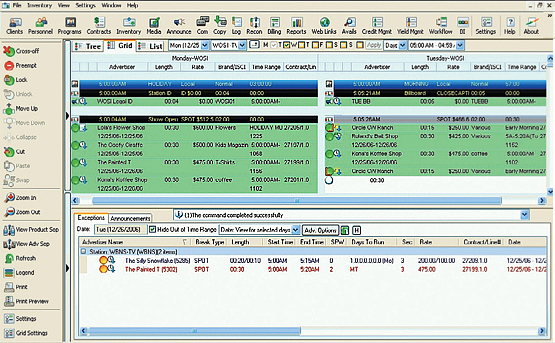Web, Mobile Add Complexity to Traffic Ops
OTTAWA
Book the TV ads, run 'em and then bill 'em. That's how life was for the average traffic and billing system. But things have become exponentially more complicated for this technology, now that broadcasters have ventured into online and mobile advertising. Suddenly their traffic departments have to book and bill quickie video clips, banner ads and clickable icons, in addition to the tried-and-true 30-second commercials that have paid the bills for the last 60 years.

Bob Furlong "Rather than having a linear business model, we as an industry have evolved to a nonlinear business model where broadcasters are now distributing content and ads across three to five channels on different platforms compared to one analog channel in years past," said Robert Furlong, president and CEO of VCI Solutions. "That's a fundamental change."
Robert Lamb, Pilat Media's CTO agrees with Furlong.
"We no longer live in a straightforward linear world," Lamb said. "With the move into nonlinear ads on the Web and mobile, the traffic and billing world has changed. Old-fashioned traffic and billing software just can't keep up."
END-TO-END CHALLENGES
In the old days, TV commercials would be sold through the station's sales department, who would then pass the bookings onto the traffic department. Traffic would handle the scheduling of the times and frequency for running the ads; ensure that the videotapes got played or that make-goods were issued for those ads that didn't run, and then invoice the client for payment.
Today, everything has changed. Customers can order ads through a sale rep, but they can also e-mail their requests into the station directly. And they don't just have to pick playout on broadcast television. They can now select exposure on multiple platforms and in multiple formats, including text, graphics and interactive applications. Meanwhile, the client's TV ads can also be inserted into streaming content on the station's Web site; whether as part of an on-demand stable of TV programs, a bumper that sits between users and the news clips that they want to watch, or anything else a creative Web designer might think up.
The measurement metrics are also different.
"In the past, stations would have to pull their logger tapes, and then make VHS copies to prove that they had aired a sponsor's commercials, sponsored elements, or logos as booked," said Russell Wise, vice president of sales and marketing at Volicon. "With our Volicon Observer platform, of course, this verification can now be done electronically."
"With Observer software an operator can review the broadcast from a desktop PC, find the clip in question and e-mail it to the sponsor," he continued. "But that's broadcast TV. To do this on the Web, we have to work with third-party providers to get data to prove what was seen online, and by how many people."
When the measurements have been taken, there's the issue of billing. Broadcasters might be selling across various channels, but they still want their billing departments to issue single invoices to their clients in order to keep their "accounts receivable" and "collections" processes simple and straightforward.
And that's not all.
"Our broadcast customers also want single contracts that encompass all the various platforms a given client is using," said John Patrick, Harris' director of product management for OSi Traffic and Billing Systems. "At Harris, we are always expanding the capabilities of our OSi traffic and revenue management systems, which is why we recently introduced OSi-Cablenet to handle the unique traffic and billing needs of cable TV networks. But the online and mobile worlds demand more in terms of ordering, tracking, and invoicing. Frankly, this is a quantum leap, and we and the industry are working on making it."
Michael Ambrose, product manager with WideOrbit, echoed these concerns.

OSi Traffic Inventory
"Because it is becoming increasingly more important for our clients to expand their online revenue channels, we are presently engaged with multiple vendors and clients to help define the requirements for more dynamic order entry and detailed invoicing capabilities for Internet orders, which will be launched in an upcoming release of WO Traffic," Ambrose said.
"Working with today's traffic and billing demands is a huge challenge that everyone is still trying to figure out, and one that we are working on," said Jamie Meyer, VCI Solutions' vice president of product development. "It is the multimedia landscape that has been thrust upon us with HD, digital subchannels, Web, and mobile."
STILL WORKING ON SOLUTIONS
All of the manufacturers who spoke to TV Technology said that they are enhancing their systems to keep up with today's multimedia traffic and billing needs. But the sheer complexity of these tasks means a quick fix is not in the cards.
The industry's dilemma is summed up by VCI Solutions' Robert Furlong.
"We do not have an official end date of when we will provide our clients with the be-all-end-all solution and that is because just as fast as technology is rapidly evolving so too are we and our customer's workflow," he said. "It will be an ongoing process as we are continually enhancing our system's functionality to provide more efficient workflows across all media platforms for our clients."
The professional video industry's #1 source for news, trends and product and tech information. Sign up below.
James Careless is an award-winning journalist who has written for TV Technology since the 1990s. He has covered HDTV from the days of the six competing HDTV formats that led to the 1993 Grand Alliance, and onwards through ATSC 3.0 and OTT. He also writes for Radio World, along with other publications in aerospace, defense, public safety, streaming media, plus the amusement park industry for something different.

